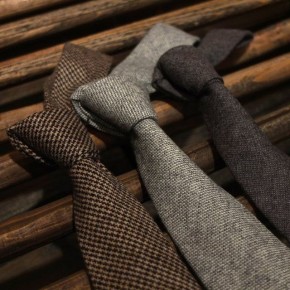A Gentleman’s Guide to Finding the Perfect Tie
The necktie is thought to have caught on in the 17th century during the 30-year war in France when King Louis XIII hired Croatian soldiers who wore a tie as part of their uniform. It was a small garment used to tie the top of the soldiers’ jackets but the king liked it so much that he ordered anyone coming to his court to wear it permanently. This item of clothing was referred to as a cravat. Ties have since evolved as fashion accessories for men over the centuries, finally becoming essential business wear for executives as well as a part of formal and evening wear for men today. The right tie can be a perfect finishing touch to your outfit, while a bad tie will ruin your ensemble and leave people questioning your sense of style and possibly even your sanity in extreme cases.
 Nowadays, millions of ties are produced the world over to help business people and fashion-savvy men everywhere complete their overall ensemble and make the desired fashion statement. Selecting the right necktie is often a critical decision as regardless of the tie you choose, you are communicating something about yourself to the people around you. The right piece can influence people’s opinions of you for the better or result in their remembering you as ‘that guy with the awful polka dotted tie’ every time they see you. Fortunately, there are several tips that can help you select the best choice for your outfit, and spare you the embarrassed side glances and uncomfortable silences from others that tell you that you have made a wardrobe faux pas.
Nowadays, millions of ties are produced the world over to help business people and fashion-savvy men everywhere complete their overall ensemble and make the desired fashion statement. Selecting the right necktie is often a critical decision as regardless of the tie you choose, you are communicating something about yourself to the people around you. The right piece can influence people’s opinions of you for the better or result in their remembering you as ‘that guy with the awful polka dotted tie’ every time they see you. Fortunately, there are several tips that can help you select the best choice for your outfit, and spare you the embarrassed side glances and uncomfortable silences from others that tell you that you have made a wardrobe faux pas.
Gentlemen, This is How you Find the Perfect Tie
Finding the perfect tie can be tantamount to locating the proverbial needle in the haystack. With neckties coming in infinite colours, fabrics and designs, locating the right piece to add to your wardrobe can be frustrating to say the least.
However, by following a few simple guidelines, you will be able to separate the wheat from the chaff, ensure that you select the perfect neckpiece to complete your ensemble and present the picture of a well put together, fashion savvy gentleman of the world.
1. All Fabrics are Not Created Equal
Most designers and aficionados inform us that the best pieces are made from 100% silk. However, there are several fabric blends that also result in a good quality item. These include; linen and cotton blends, worsted wools, tweeds and cashmere.
 The right blend is usually determined by the season which means that silk, cotton and linen blends are best for summer, while wool blends are ideal for fall and winter.
The right blend is usually determined by the season which means that silk, cotton and linen blends are best for summer, while wool blends are ideal for fall and winter.
If you prefer to go with silk however, then you need to learn how to recognize a quality fabric by feel or enlist the help of an experienced sales person to help you make the choice.
Furthermore, 100% silk tends to be expensive, and you will want to ensure that you are getting the highest quality. A lot of the silk used for making ties comes from China but processing methods can compromise the quality of the silk. Silk processing methods are responsible for the huge differences in pricing with Italy and England being on the higher end ahead of China and other silk producing countries.
2. A cut above the rest
Good quality ties should always be cut on the bias and at a 45 degree angle. This type of cutting ensures that your tie falls straight down after you have finished tying your knot instead of twisting and curling in different directions.
You can confirm a bias cut by draping your necktie over the back of your hand before you purchase it. If it drapes smoothly and in straight line, then the cutting has been done correctly. If not, then continue looking until you find one that meets your requirements.
3. Welcome to the Fold
Ties have traditionally been made with three folds but more recently, the number has been increased with some ties having up to twelve folds. Increasing the number of folds help to add weight to the piece as well as increase its drape.
Furthermore, multi folded ties are more likely to be made with better quality material and be handcrafted which results in a greater overall quality. Other factors to consider under construction include the tip, interlining and stitch.
Dimpling and wrinkles on the tip are things to look out for in order to determine whether the construction was well done. The interlining is also important. If yours is not made from a strong outer material (envelope), then the inner lining needs to be made of a more robust material such as wool or a wool blend in order to help it keep its shape and drape better.
Finally, consider the kind of stitching that has been used in constructing your neckpiece. The best quality ties are usually stitched by hand in order to make the joining last longer. Machine stitching results in finer stitches but these usually come apart faster.
4. Shifting Shapes
Good quality pieces will retain their shape even after washing and ironing. However, it is not possible to wash and iron yours at the store so you need to use other methods to determine this. The best way is to tug both ends of the tie slightly and then release it to see whether it will bounce back to its original shape.
5. Fit for Purpose
The final step in picking your choice involves trying it on to see how well it goes with your clothing, as well as your height and stature. You do not want to go for the expensive, handcrafted, seven-fold silk option, only to get home and discover that it does not go with your chambray shirt or to find that it only reaches halfway down your torso. By taking the time to do a proper fitting at the store, you can avoid these eventualities and select the perfect piece to complement your outfit and complete your chosen ensemble perfectly.
The right knot can help you make the right fashion statement and influence people’s opinions of you for better or for worse. By taking the time to select the perfect option to go with your particular style, you can send the right message and solidify your reputation as the well put-together and fashion- savvy gentleman that you are.
